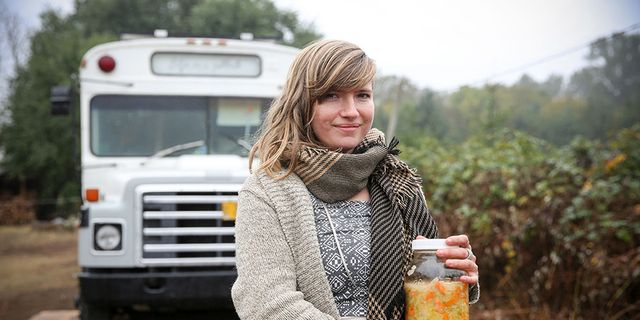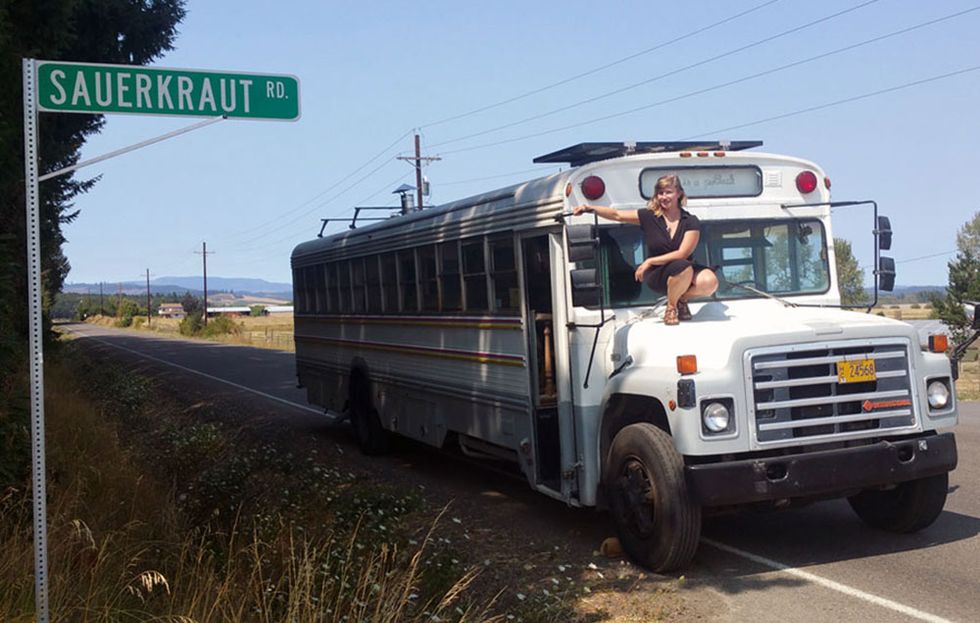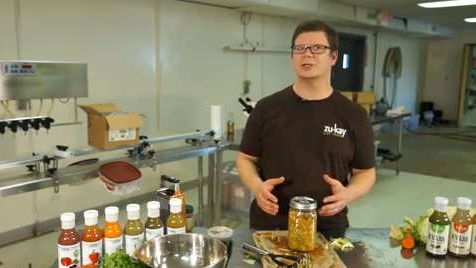When Tara Whitsitt first learned to make sauerkraut from a friend, she was blown away by the color changes she witnessed as the cabbage fermented. “I had the realization, ‘Oh, I’m growing an ecosystem in a jar," she says, "That’s amazing!’"
She explains, "I hadn’t experienced nature in such an intimate format before, and so fermentation led me on this really deep journey.” The journey Whitsitt refers to isn’t a metaphorical one—it involves an old 40-foot military bus converted into traveling fermentation lab.
Learning how to make sauerkraut fueled Whitsitt’s interest in the natural world, so she traded her urban existence in New York City for a home in the Pacific Northwest, an area she describes as “a wild nature paradise.” She had always led a nomadic life, and after discovering her love for fermentation, a crazy dream began fermenting in her mind. She asked herself, “What if I decided to go travel to these urban spaces where people aren’t regularly being exposed to this microbial food world, and brought it to them?”
(Brag your love of gardening with the Organic Life 2018 Wall Calendar, featuring gorgeous photographs, cooking tips and recipes, plus how to eat more—and waste less—of what's in season.)
In 2013, Whitsitt bought the bus that became Fermentation on Wheels. She now travels the country teaching hands-on workshops about DIY fermentation and sustainable living practices. It’s important to her that the educational model is interactive and community driven. She says, “I really struggled in my youth with academia, and these more traditional forms of education. What I would’ve really loved when I was younger was to explore things in a more hands-on manner.”
Fermentation on Wheels has nonprofit status through its fiscal sponsor, Fractured Atlas. Whitsitt says, “Fermentation on Wheels supports itself, and barely me, but I don’t need much, so it works.” Whenever she’s traveling, the bus is full of fermented foods—and those glass jars of sauerkraut and kefir are more than just teaching tools. Not only does she eat them herself, she uses her yogurt, kombucha, and sourdough bread to barter for things like mechanical repairs to the bus.
You can read more about Whitsitt’s travels in her book, Fermentation on Wheels: Road Stories, Food Ramblings, and 50 Do-It-Yourself Recipes from Sauerkraut, Kombucha, and Yogurt to Miso, Tempeh, and Mead. Published by Bloomsbury in September, it is both a memoir of her first two years on the road and a cookbook of simple fermenting recipes. It turns out pickling isn’t Whitsitt’s only passion. The book is full of delightful sketches of fermentation tools and ingredients, as well as hand-lettered chapter titles. She did them all herself.
Related: The Truth About Probiotics
At a recent workshop in Los Angeles organized by Food Forward, a local nonprofit, Tara Whitsitt demonstrated how to chop and massage cabbage to make sauerkraut. About twenty students followed along, salted the cabbage to taste, and then packed it into gallon jars that would go onto Whitsitt’s bus. In a few weeks, that sauerkraut would be ready, but in the meantime, she brought out sauerkraut made by a previous class for the current students to taste.
At the end of the workshop, she offered tours of her bus, which is a showcase of sustainable living. On the inside, there are few signs of the vehicle’s military past. It’s now a homey workspace, decorated with Whitsitt’s art and packed with jars of fermenting food and drinks, several of which she opens and shares. A map on one wall has pins to mark the locations of previous workshops.
Watch this video how-to on making sauerkraut:
Whitsitt’s next bus tour will take her through several western states, including Arizona, New Mexico, Colorado, Utah, Wyoming, and Montana. Down the road, she has even bigger plans for Fermentation on Wheels. Maneuvering a 40-foot bus has been challenging on the East Coast, so she says, “I’m looking into getting a second bus that would be my East Coast bus, and it might even be a camper van, a smaller version. Maybe I’ll have someone on the West Coast who wants to run this bus while I’m running the East Coast bus.” She also dreams of one day having a home base for the organization—a big space with a commercial kitchen where she can do workshops and artists’ lofts for people doing food arts and food writing. She envisions “an art space that’s also food oriented, where people can come and eat a lot of food together.”
Related: How To Make Vegan Yogurt Without Funky Additives
For now, Whitsitt continues to sell starter cultures on the road. She explains that the natural cultures on the fermentation bus often last longer than the lab-grown, commercial varieties available online, because big companies have a financial incentive to keep customers coming back for more.
When a fellow student asks about buying one of the cultures, I realize that Whitsitt is sort of the human version of a starter culture. As she travels the country, she teaches others about traditional food-preservation techniques, and encourages them to grow that new knowledge on their own by experimenting with different flavors and fermentation times.
Some of her students will eventually teach others how to make sauerkraut, spreading what they’ve learned even farther. If Fermentation on Wheels is a culture, it seems destined to thrive—and the results will be delicious.
Related: How To Make Fermented Pickles
Basil, Mint & Cucumber Kimchi
Yields 1 quart, in 1-2 weeks
To keep cucumbers crunchy, I ferment them at room temperature for a short period and then at cooler temperatures. You may also add natural tannins, such as grape or oak leaves, to promote crispness. This recipe features the cooling, bright flavors of basil and mint. I make it spicy with ginger and garlic.
2 cucumbers
1 tablespoon salt
1⁄3 cup basil leaves
1⁄3 cup mint leaves
¼ cup green onion
3 cloves garlic
1 inch ginger root
1 teaspoon chili powder
1 teaspoon fish sauce or tamari
1. Rinse and destem cucumbers and slice them in thin rounds. A mandoline is an ideal tool for the job, but you can use a knife instead. Add salt and gently toss the cucumbers. The idea is to let the salt slowly pull water from the cucumbers rather than massage them with salt, so the cucumbers keep their form.
2. Finely chop mint, basil, and green onion and mix with cucumbers in a bowl. Gently toss ingredients again.
3. Combine garlic, ginger, chili, and fish sauce in a blender. Add the paste to the prepared ingredients and gently mix. Let sit for an hour.
4. The ingredients will have produced a salty puddle when you come back to them. If the puddle is minimal, wait another hour or simply pack into a jar and top off with water. If you top off the jar, place a lid on top and give the jar a few thorough shakes to disperse the salt.
5. Add a fermentation weight, cover with a cloth and rubber band, and leave the kimchi for 3–5 days at room temperature, then chill in the fridge 1–2 weeks. Enjoy when it’s to your liking.















